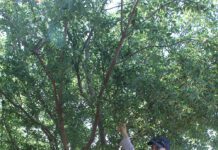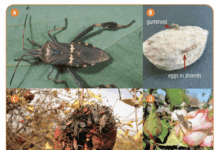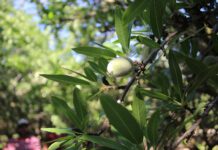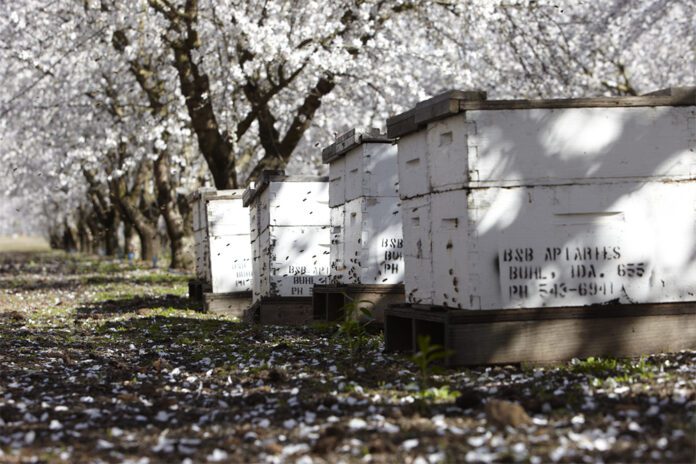
During tough economic times like the almond industry has experienced over the last two years, finding ways to add value to your operation can be a proactive way to make the best of the situation.
Establishing pollinator habitat, for example, is a value proposition California almond growers can do that helps boost the health and longevity of orchards and provides vital support to honeybees.
The opportunity for growers to get involved in this initiative is greater than ever. California almond growers are eligible to receive free cover crop seed through the Seeds for Bees program through Project Apis.m. Additionally, growers have two cost-sharing opportunities they can engage in. Both the Natural Resources Conservation Service (NRCS) and California Department of Food and Agriculture (CDFA) have programs in conjunction with Pollinator Partnership, each with over $1 million of funds available to growers.
“Growers recognize the value of pollinators,” said Josette Lewis, chief scientific officer at ABC. “They pay a lot of money for those bees, and they’ve really responded to the opportunity to demonstrate that value. In just a few years, we’ve seen a threefold increase in the planting of pollinator specific cover crops.”
“Research sponsored by the Almond Board of California (ABC) at UC Davis shows honeybees are healthier coming out of orchards that have a blooming cover crop,” said Lewis. “It provides more diverse nutrition before and after bloom if there is a pollinator-specific cover crop in between those tree rows.”
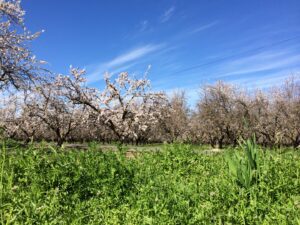
Beekeepers also favor orchards that provide additional forage for bees, sometimes with a slightly reduced cost of service or providing better-quality hives. Groundwater recharge, soil quality, water retention and beneficial insects for biocontrol are also advantages growers have gleaned from pollinator habitat in and around their orchards.
And the value doesn’t stop at the grower level. Almond processors are beginning to see more buyer preferences with how the tree nut is grown in relation to pollinator stewardship, allowing handlers to position themselves differently on the market. Some handlers are even providing financial incentives to growers who implement these practices.
Endangered Species Causing Threat
With over 373,000 almond acres certified under Bee Friendly Farming, ABC supports these efforts among growers by reducing entry barriers or obstacles they may face. One of those obstacles on the agenda for 2024 is listings under the state and federal Endangered Species Act (ESA).
The almond industry is facing two listings that will affect the way growers can conduct their business that may impact endangered pollinators. At the state level, four native bumblebees are being considered by the California Department of Fish and Wildlife under the ESA, while the monarch butterfly is being considered at the federal level.
So, how does this impact growers? If these considerations go forward, it will affect pesticide registrations and how products can be used by growers to control problematic pests. Additionally, growers who have implemented a pollinator habitat can be up for legal risk if the habitat or pollinators are accidentally harmed through normal farming practices, despite the voluntary investments made by growers to support these species.
“We tend to get blamed, oftentimes unfairly, for a lot of issues going on in the world of pollinators, so it becomes an important reputation management concern for our industry, and one where we don’t want consumers to pause in purchasing almonds if they think we’re not doing right by pollinators because as we’ve seen, the data shows you guys are really stepping up and doing a lot,” Lewis noted.
Collaborating to Protect the Industry
To protect growers who have added habitat, ABC has teamed up with other ag groups to safeguard those operations. Most notably, the Almond Alliance has joined ABC in actively engaging on these issues to prove “grower practices can actually be a net benefit to our species, our ecosystem and to the health of our resources,” said Aubrey Bettencourt, president and CEO of the Almond Alliance.
Bimonthly over the last year, Lewis and Bettencourt have met with ag partners and state and federal Fish and Wildlife Services to develop realistic goals and ensure the listings are “not written in an overly robust or regulatory way that would limit our ability to continue to support the species,” Bettencourt said.
One of the solutions they will be putting forward is a Candidate Conservation Agreement with Assurances, or CCAA, in conjunction with the state equivalent, a Voluntary Local Program. Under these federal and state programs, the almond industry would be acknowledged for voluntarily contributions to protect monarch and native bees and, in exchange, growers can receive protection from legal action from normal farming operations. A CCAA must be completed before the species is listed, which could happen by September 2024. The coalition of ag groups, led by the almond industry, anticipates submitting their application on behalf of the industry over the coming months.
Parallel to these efforts, the Environmental Protection Agency (EPA) is in the process of reevaluation of how they factor endangered species listings into the pesticide registration process. Lawsuits require EPA to move more quickly to account for endangered species.
“Depending on how the listings of the monarch and the bumblebees are done, that gets taken into consideration in the new ESA review process,” Bettencourt said.
Since this new process at the EPA is on the same timeline as the endangered species listings, the Alliance is pushing to allow for more authority from the U.S. Fish and Wildlife Service, which will be an added benefit to the almond industry in the long run.
“Interestingly enough, the Fish and Wildlife Authority has the ability to acknowledge a process that EPA is doing, but EPA unfortunately does not have the ability to acknowledge when Fish and Wildlife does something like a CCAA or Safe Harbor,” Bettencourt said.
Joint Efforts
Positively, ABC and the Alliance are optimistic for these outcomes because possibly for the first time ever, agencies and growers are working together to write these initiatives. Unlike most regulations placed on growers, the Alliance does not foresee state and federal agencies senselessly restricting growers and their habitat efforts and that’s likely because of the good rapport already built by the almond industry.
And, to the benefit of the industry, these listings are happening at the same time.
“For the first time ever, we have the right alignment of financing, both public and private,” Bettencourt concluded. “We have the right alignment of actors, both state and federal. We actually have a really common goal.”



